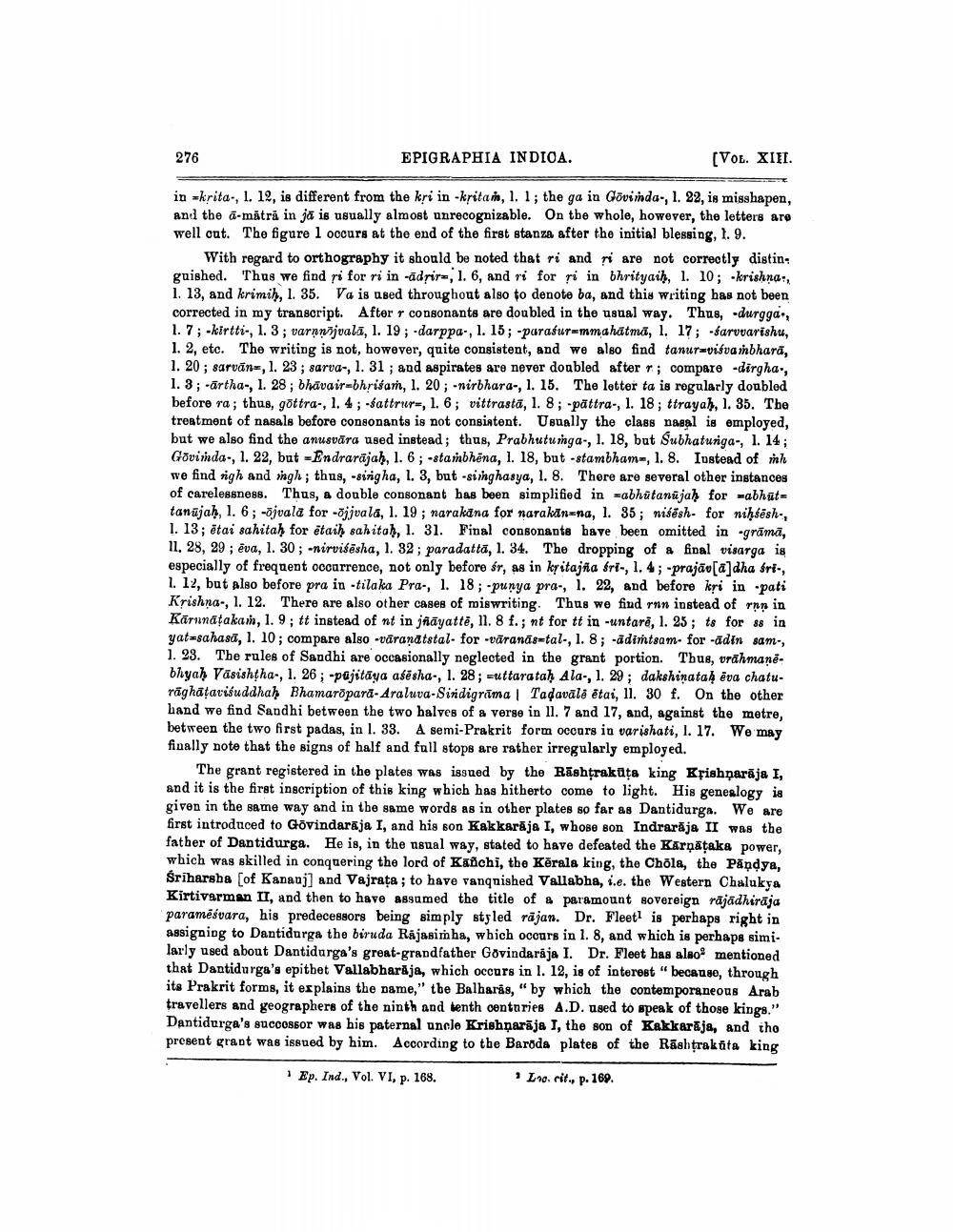________________
276
EPIGRAPHIA INDIOA.
(VOL. XIII.
in =krita, 1. 12, is different from the kri in -kritan, 1. 1; the ga in Govinda., 1. 22, is misshapen, and the a-matra in ja is usually almost unrecognizable. On the whole, however, the letters are well cut. The figure 1 occurs at the end of the first stanza after the initial blessing, 1. 9.
With regard to orthography it should be noted that ri and ri are not correctly distin. guished. Thus we find ri for ri in -ādsirs, 1. 6, and ri for fi in bhrityai), l. 10; krishna:, 1. 13, and krimih, 1. 35. Va is used throughout also to denote ba, and this writing has not been corrected in my transcript. After consonants are doubled in the usual way. Thus, -durgga, 1. 7; -kirtti-, 1. 3; varnnājvala, 1. 19; -darppa-, 1. 15; -parafur=mmahatmā, 1. 17; -farvvarishu, 1. 2, etc. The writing is not, however, quite consistent, and we also find tanut visvambharā, 1. 20; sarvāns, 1. 23; sarva-, 1. 31; and aspirates are never doubled after r; compare -dirgha., 1. 3 ; -ārtha-, 1. 28; bhāvair-bhrisar, 1. 20; -nirbhara-, 1. 15. The letter ta is regalarly doubled before ra; thus, gõttra-, 1. 4 ; -fattrurs, l. 6; vittrastā, 1. 8; -pättra-, 1. 18; ttrayah, 1. 35. The treatment of nasals before consonants is not consistent. Usually the class nasal is employed, but we also find the anusvāra used instead; thus, Prabhuturga., 1. 18, but Subhaturiga., 1. 14 ; Govinda-, 1. 22, but - Endrarājah, 1. 6; -stanbhēna, l. 18, but -stambham-, 1. 8. Instead of nih we find righ and nigh; thus, -sirgha, 1. 3, but -si inghasya, 1. 8. There are several other instances of carelessness. Thus, a double consonant has been simplified in Eabhūtanūjah for rabhūts tanūjah, 1. 6; -ājuala for -õjjvala, 1. 19; narakāna for narakanena, l. 35; nisésh- for niņtēsh., 1. 13; ētai sahitah for ētaih sahitah, 1. 31. Final consonants have been omitted in -grāmā, 11, 28, 29; ēva, 1. 30; -nirvisēsha, 1. 32; paradattā, 1. 34. The dropping of a fipal visarga is especially of frequent occurrence, not only before sr, as in kitajna sri-, 1.4; prajāv[a]dha Sri., 1. 12, but also before pra in -tilaka Pra-, l. 18; -punya pra-, I. 22, and before kri in pati Krishna., 1. 12. There are also other cases of miswriting. Thus we find ran instead of rnn in Kārunāțakan, 1.9;tt instead of nt in jñāyattē, 11. 8 f.; nt for tt in-untară, 1. 25; ts for s8 in yat sahasā, 1. 10; compare algo -våranatstal- for -vāranās=tal., 1. 8; -ādintsam- for -ādin sam-, 1. 23. The rules of Sandhi are occasionally neglected in the grant portion. Thus, vrähmanebhyah Vásishtha., 1. 26; -pajitaya aśësha-, 1. 28; ruttara tah Ala., 1. 29; dakshinata ēva chaturāghățarisuddhah Bhamaropard-Araluva-Siridigrīma | Tadavāla ētai, 11. 30 f. On the other hand we find Sandhi between the two halves of a verse in 11. 7 and 17, and, against the metre, between the two first padas, in I. 33. A semi-Prakrit form occurs in varishati, I. 17. We may finally note that the signs of half and full stops are rather irregularly employed.
The grant registered in the plates was issued by the Rashtrakuța king Kțishnarāja I, and it is the first inscription of this king which has hitherto come to light. His geneslogy is given in the same way and in the same words as in other plates so far as Dantidurga. We are first introduced to Govindaraja I, and his son Kakkarāja I, whose son Indrarāja II was the father of Dantidurga. He is, in the usual way, stated to have defeated the Karnataka power, which was skilled in conquering the lord of Kanchi, the Kerala king, the Chola, the Pāņdya, Śriharsha [of Kananj] and Vajrata ; to have vanquished Vallabha, i.e. the Western Chalukya Kirtivarman II, and then to have assumed the title of a paramount sovereign rājādhiraja paramēšvara, his predecessors being simply styled räjan. Dr. Fleetl is perhaps right in assigning to Dantidurga the biruda Rajasimha, which occurs in l. 8, and which is perhaps similarly used about Dantidurga's great-grandfather Govindaraja I. Dr. Fleet has also mentioned that Dantidurga's epithet Vallabharăja, which occurs in l. 12, is of interest “because, through its Prakrit forms, it explains the name," the Balharás, " by which the contemporaneous Arab travellers and geographers of the ninth and tenth centuries A.D. used to speak of those kings." Dantidurga's succossor was his paternal uncle Krishnarāja I, the son of Kakkarāja, and tho present grant was issued by him. According to the Baroda plates of the Rashtrakāta king
Ep. Ind., Vol. VI, p. 168.
Lho. cit., p. 169.




